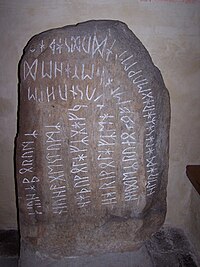Stentoften Runestone
| Stentoften Runestone | |
|---|---|
 |
|
| Rundata ID | DR 357 |
| Country | Sweden |
| Region | Blekinge |
| City/Village | Stentoften |
| Produced | 500-700AD |
| Runemaster | Unknown |
|
Text – Native |
|
| Proto-Norse : <niuha>borumz <niuha>gestumz Haþuwulfz gaf j[ar], Hariwulfz ... ... haidiz runono, felh eka hedra niu habrumz, niu hangistumz Haþuwulfz gaf j[ar], Hariwulfz ... ... haidiz runono, felh eka hedra ginnurunoz. Hermalausaz argiu, Weladauþs, sa þat briutiþ. | |
| Text – English | |
| (To the) <niuha>dwellers (and) <niuha>guests Haþuwulfar gave ful year, Hariwulfar ... ... I, master of the runes(?) conceal here nine bucks, nine stallions, Haþuwulfar gave fruitful year, Hariwulfar ... ... I, master of the runes(?) conceal here runes of power. Incessantly (plagued by) maleficence, (doomed to) insidious death (is) he who this breaks. | |
| Other resources | |
|
Runestones – Runic alphabet Runology – Runestone styles |
|
The Stentoften Runestone, listed in the Rundata catalog as DR 357, is a runestone which contains a curse in Proto-Norse that was discovered in Stentoften, Blekinge, Sweden.
This is the English translation provided by Rundata:
In lines AP and AQ, in the phrase "gaf j" ("gave j"), the j-rune is an ideogram which stands for its rune name jara, meaning "harvest" or "bountiful or fruitful year." One author suggests that line AQ is describing an animal sacrifice in return for a good harvest as part of a fertility ritual.
The Stentoften runestone was discovered in 1823 by the dean O. Hammer. It was lying down with the inscription facing downwards, surrounded by five sharp larger stones forming a pentagon or a pentagram. Consequently, the stone has been part of a larger monument like the Björketorp Runestone further east. In 1864, the runestone was moved into the church of Sölvesborg.
Most scholars date the inscription to the 7th century and it is carved with a type of runes that form an intermediate version between the Elder Futhark and the Younger Futhark. A characteristic example of this is the a-rune ![]() which has the same form as the h-rune of the younger futhark. This is the rune that is transliterated with A. The k-rune, which looks like a Y is a transition form between
which has the same form as the h-rune of the younger futhark. This is the rune that is transliterated with A. The k-rune, which looks like a Y is a transition form between ![]() and
and ![]() in the two futharks. There are quite few intermediary inscriptions like this one. Three more are known from Blekinge, i.e. the Björketorp Runestone, the Istaby Runestone and the Gummarp Runestone, which were moved to Copenhagen and lost in the Copenhagen Fire of 1728.
in the two futharks. There are quite few intermediary inscriptions like this one. Three more are known from Blekinge, i.e. the Björketorp Runestone, the Istaby Runestone and the Gummarp Runestone, which were moved to Copenhagen and lost in the Copenhagen Fire of 1728.
...
Wikipedia
